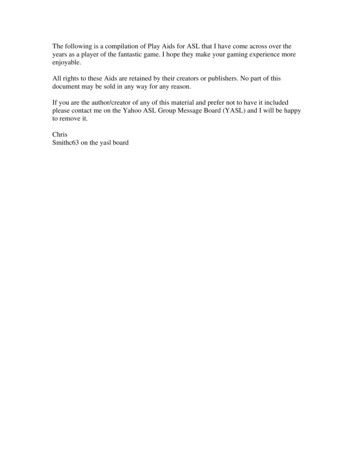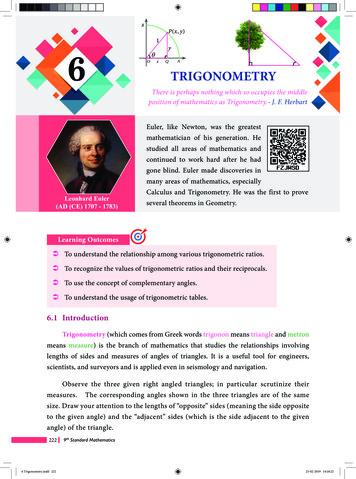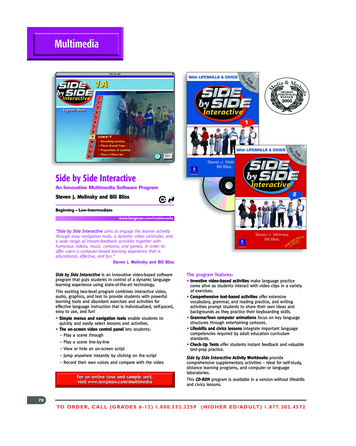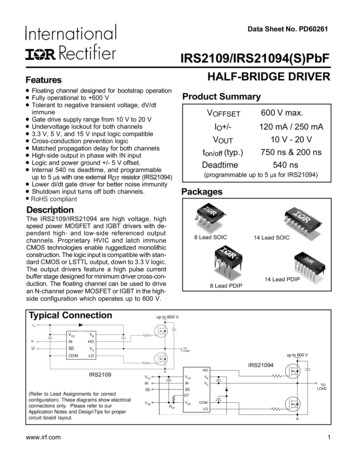
Transcription
The human side of M&A:Selecting an HRIS delivery modelPart of the #Tech @the heart of M&A serieson M&A technology topics1
The human side of M&A: Selecting an HRIS delivery modelAn important priority for organizations engaged in adivestiture is to quickly and cost-effectively start up anddeliver human resource (HR) services to enable a smoothemployee transition from parent company (RemainCo) to anew organization (NewCo). Many NewCos are accustomedto relying on the RemainCo to provide HR and otherback-office processes, services, and systems. Due to thisprevious dependence on RemainCo and the perceivedneed to create something new, NewCos may leverage thedivestiture as an opportunity to select and tailor their HRInformation Systems (HRIS) to their specifications and needsas a new organization. While doing so, they should focuson minimizing cost, mitigating business disruption, andmanaging a short time-to-close window. It is important,therefore, to select an HR technology strategy and HRISdeployment model that will meet NewCo’s strategic,operational, and employee needs.HRIS deployment model optionsIn addition to client-specific considerations, a divestitureenvironment has a number of recurring factors that tendto heavily influence HRIS technology and service deliverymodel decisions. For example, when defining the HR ServiceDelivery Model strategy for Day 1 and Day 2, a NewCoshould assess its current-state HR operating model anddetermine which process and technology changes andwhich deployment approach (local, regional, global) wouldhelp optimize the future-state HR organization’s efficiencyand effectiveness. This process should be done in tandemwith developing NewCo’s overall enterprise IT strategy toalign HR and broader technology decisions and enablesynergies with vendors around cost, service, and interfaces(for example, general ledger, travel and expense, andfinancial consolidation processes).Before analyzing some common HRIS selectionconsiderations in a divestiture environment, it is helpfulto understand the differences among the three majorHRIS system delivery models: Software as a Service (SaaS),outsourced, and traditional Enterprise Resource Planning(ERP) (figure 1).Figure 1:Spectrum of IT service deliveryIT capital expendituresTraditional cpap ntd merce ageutso anOu mtfdsteHoITplaedtramordanwyollFudneeopDegree of ownershipSoftware as a Service (SaaS): In a SaaS environment, the HRIS solution is fully hosted and managed by a third-partysoftware vendor who is responsible for the application, the infrastructure, and ongoing support. The characteristics of adivestiture have made SaaS platforms a popular choice for companies looking to start up their HR function quickly and costeffectively. In addition, SaaS platform functionality can be enhanced over time because vendors generally release solutionupdates two to four times per year.Outsourced: In an outsourced model, the organization engages a third-party vendor to supply the system software,hardware, and a range of support services (such as payroll processing and HR administration) under a single contract.Traditional ERP (On premises): In a traditional ERP model, the organization owns and maintains the hardware andinfrastructure. Software licenses are purchased outright for a set fee based on employee population and module scope.Software configuration, support, and enhancements are managed, developed, and tested internally; this gives theorganizations the highest level of control when customizing the HRIS solution.2
The human side of M&A: Selecting an HRIS delivery modelMore organizations are choosing SaaS and outsourced HRIS modelsIndustry observations and Deloitte’s work with companies engaged in divestitures with 100-8,000 employees haverevealed an important trend: Over the past three years, HR technology selections during a divestiture have moved awayfrom ERP models to a fairly even split of SaaS and outsourced solutions. Selection decisions typically hinge upon severalrecurring considerations (figure 2).Figure 2:ConsiderationWhy it is importantERP modelTransitionServicesAgreements(TSAs)RemainCos typically tryto minimize TSA servicesand push for quick exitsfrom TSAs, creatingurgency to quicklylaunch the HRIS solution. May require longerimplementationtimeline due to needto set up hardwareand infrastructuresolutions in additionto configuration/customization May require shorterimplementation timeline due touse of vendor’s existing hardwareand infrastructure; focus is onconfigurationTime to closeThe structure of manydivestiture deals includesa short time to close andlimited or no post-closeRemainCo TSA support. Generally requireslonger implementationtimeline, which maynot be compatiblewith a deal structurethat includes a shorttime to close andlimited or no postclose TSA support Provide opportunity for singlecontract for technology andoutsourcing services ( payrolloutsourcing, for example),eliminating the need for theNewCo to build those capabilitiesin house Requires highly skilledresources that theNewCo may not havein houseTimingof capitalexpenditure3Newly spun-offcompanies may not beable to afford directing alarge capital investmentaway from the business,making the paymentschedule and theassociated cash flowimpact an importantconsideration. Potentially has higherupfront capital costsfor hardware andsoftware licensing Is typically paid forout of the capitalexpenditure budgetrather than theoperating budgetSaaS and outsourced models Can leverage the third-partyprovider’s established processes,controls, and personnel May require smaller upfrontinvestment; just implementationand subscription costs Are typically paid for out of theoperating budget rather thancapital expenditure budget Payment terms differ byvendor; some begin chargingfor subscriptions at the time ofcontracting, not go-live
The human side of M&A: Selecting an HRIS delivery modelConsiderationWhy it is importantERP modelTotal Cost ofOwnership(TCO)There is often pressureon the NewCo todemonstrate valuequickly and with fewerresources than theRemainCo has at itsdisposal. Often has a higherTCO due to cost ofinfrastructure hosting,data security, andhardware maintenance Often have a reduced TCO anda continual upgrade model todeliver the latest functionalityThe RemainCo mayretain the highlyskilled and historicallyscarce technicalresources (applicationdevelopers and databaseadministrators). Generally necessitatesa higher level oftechnical resources tomanage, develop, andtest configuration andenhancements Can reduce dependency oninternal IT because vendormanages upgrades, includingtestingHR operatingmodel Depends heavily onIT for functional andtechnical supportHRIS system implementation and managementchallengesImplementing and managing a SaaS or web-based/outsourced HRIS model are both relatively easy comparedwith a traditional ERP model; however, organizations stillmay encounter some pitfalls and challenges.SaaS delivery model considerationsContracting and fees: Some vendor contracts stipulatethat billing will begin the first time the client accesses theenvironment. This billing model can be taxing to a NewCo’scash flow when it’s trying to mitigate pre-Day 1 expenses.Also, the NewCo HRIS set up may take place before theactual NewCo is legally established, again presenting acash-flow risk. An organization should clarify the billingprocess early in the delivery model selection process.Application integration: A SaaS HR solution likely willhave to be interfaced to numerous in-house and third-partyapplications. An organization should determine whichintegrations are delivered and supported by the vendor andwhich tools are available for custom integrations.Solution roadmap: In a SaaS environment, the product’sroadmap is as important—if not more important—than itscurrent capabilities. An organization should verify that itspriorities are aligned with the roadmap.4SaaS and outsourced models Transitions responsibility ofmanaging ongoing operationsto the vendor, reducing theNewCo’s need to maintain a largeHRIS service delivery team A SaaS model still requires somelevel of skilled HRIS resources tosupport vendor upgradesTest environment: SaaS providers tend to limit the numberof non-production environments. Multi-phased deploymentsmay present challenges, so an organization should evaluatethe testing strategy to determine the correct number ofenvironments.Release management and post-Day 1 solutionmanagement: An organization should proactively planfor new product releases during the HRIS implementation,as these can alter implementation timelines (for example,a release during User Acceptance Testing). To aid solutionimplementation and ongoing management, employee hiresshould include individuals with the capabilities to managesolution configuration, integration, and reports. Andbecause many SaaS solutions require annual maintenanceservices (AMS) to update or deploy new functionality, havingknowledgeable in-house staff may mitigate the annualexpense of a third-party provider performingthese tasks.Outsourced delivery model considerationsContracting and service level agreements (SLAs):During the contracting process, it is important to prioritizethe negotiating and contracting process for HRIS SLAs,solution governance, and defined escalation path for servicechallenges. If engaging with multiple third-party vendors forHR services, SLAs should account for cross-functional andcross-services items.
The human side of M&A: Selecting an HRIS delivery modelVendor business and delivery model: Some outsourcingfirms position themselves as a “one-stop shop” for acompany’s HRIS and HR administration services. However,these services actually may be managed by various vendorteams so it is important to clarify and understand thevendor’s business and delivery model.Application integration: Similar to SaaS HR solutions,outsourcing models will need to be interfaced to numerousin-house and third-party applications. The organizationshould determine which integrations are delivered andsupported by the vendor and which tools are available forcustom integrations.Business strategy alignment: An organization shouldcommunicate its business objectives and outsourcingstrategy to all vendors and provide documented processesand workflow to mitigate potential service gaps.HR services delivery model: During vendor selectionand implementation, an organization should define andvalidate the Day 1 HR service delivery model to enable clearunderstanding of which services will be retained versusoutsourced. If outsourcing a large portion of back-office,core HR services in addition to HRIS, it is important toconsider the full spectrum of HR processes (HRIS linkageto payroll, inclusive of payroll administration, tax services,and garnishment payments) to manage cost and driveoperational efficiency.In a typical divestiture, HRIS implementation timeframes are short and the NewCo’s capacity for capitalexpenditures may be limited. After weighing these andother considerations, many organizations are choosing SaaSand outsourced HRIS models to quickly and cost-effectivelystart up the HR function and focus their employees on theexciting future ahead.5ContactsBrian ProctorDeloitte Consulting LLPbrproctor@deloitte.comAndrew HellerDeloitte Consulting LLPanheller@deloitte.comNicole GeimanDeloitte Consulting LLPngeiman@deloitte.com
This communication contains general information only, and none of Deloitte Touche Tohmatsu Limited, itsmember firms or their related entities (collectively, the "Deloitte Network"), is, by means of this communication,rendering professional advice or services. Before making any decisions or taking any action that may affect yourfinances, or your business, you should consult a qualified professional adviser. No entity in the Deloitte Networkshall be responsible for any loss whatsoever sustained by any person who relies on this communication.”As used in this document, "Deloitte" means Deloitte Consulting LLP, a subsidiary of Deloitte LLP. Please see www.deloitte.com/us/about for a detailed description of the legal structure of Deloitte LLP and its subsidiaries. Certainservices may not be available to attest clients under the rules and regulations of public accounting. 2016. For information, contact Deloitte Touche Tohmatsu Limited
Software licenses are purchased outright for a set fee based on employee population and module scope. Software configuration, support, and enhancements are managed, developed, and tested internally; this gives the organizations the highest level of control when customizing the HRIS solution. The human side of M&A: Selecting an HRIS delivery model











